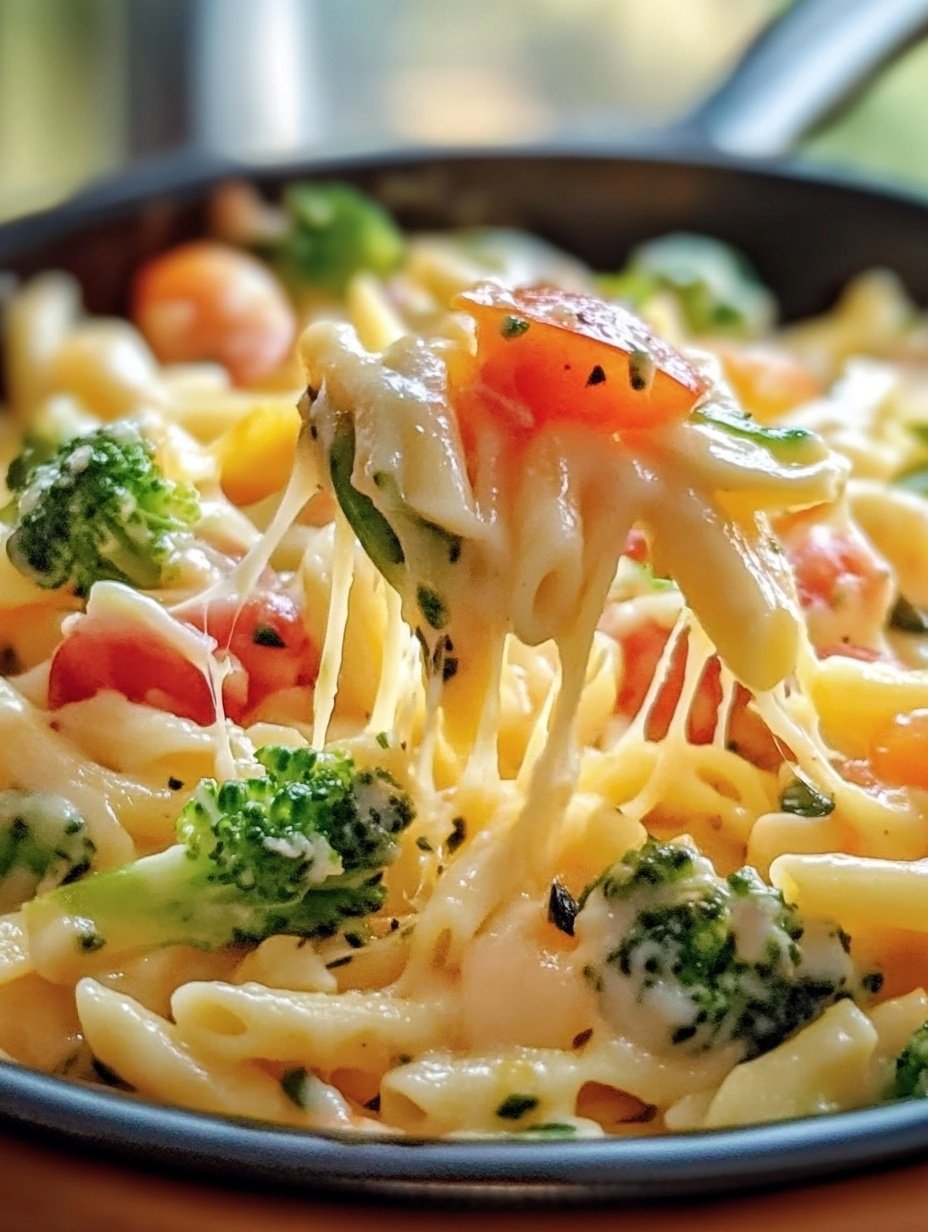A Short Story About the Recipe
I still remember the first time I made Pasta Primavera in my own kitchen. It was early spring, and the farmers’ market was bursting with fresh vegetables — crisp bell peppers, tender zucchini, and bright cherry tomatoes. I wanted a dish that captured that freshness, something that felt light yet satisfying. Pasta Primavera became my go-to solution. The name itself means “spring pasta,” and it perfectly reflects the idea of celebrating seasonal produce in a single, colorful bowl. Over time, I refined my recipe to balance the natural sweetness of vegetables with the richness of Parmesan and the comfort of perfectly cooked pasta.
Pasta Primavera has a special place in my heart because it is both simple and elegant. Whether I am cooking for myself on a busy weekday or serving a table full of friends, it never fails to bring smiles. It is a dish that feels effortless but tastes like something you could order at a restaurant.
Why You Will Love This Recipe
You will love this recipe because it combines fresh flavors, quick preparation, and a beautiful presentation. The vegetables stay crisp-tender, the pasta is al dente, and the light sauce ties everything together without being heavy. This recipe is perfect for weeknights yet impressive enough for guests. It is also a balanced meal, giving you both carbohydrates and plenty of vegetables.
Versatile
One of the best things about Pasta Primavera is how customizable it is. You can use any seasonal vegetables you have on hand — asparagus in spring, peas in summer, or even roasted squash in fall. You can also swap in gluten-free pasta or whole wheat pasta to suit your preferences. For extra protein, you can add grilled chicken, turkey bacon, or even sautéed shrimp.
Affordable
This recipe is budget-friendly and relies on simple pantry staples. Pasta, olive oil, garlic, and Parmesan are easy to keep stocked, and seasonal vegetables are usually affordable and widely available. You can make this dish for a family dinner without spending too much, and it is a great way to use up vegetables that might otherwise go to waste.
Ingredients for the Recipe
-
12 oz pasta (spaghetti, fettuccine, or penne)
-
2 tbsp olive oil
-
1 tbsp butter
-
2 garlic cloves, minced
-
1 red bell pepper, sliced thin
-
1 yellow bell pepper, sliced thin
-
1 medium zucchini, sliced into half-moons
-
1 small broccoli crown, cut into florets
-
1 cup cherry tomatoes, halved
-
1/2 cup grated Parmesan cheese
-
1/4 cup fresh basil, chopped
-
Salt and black pepper to taste
-
1/2 cup reserved pasta water
How to Prepare Pasta Primavera
Step-by-Step Instructions for Preparation
Making Pasta Primavera is straightforward, and the result is a beautiful, colorful dish that comes together in about 30 minutes. Follow these simple steps to create a perfect bowl every time:
-
Prepare the Pasta
Start by bringing a large pot of salted water to a boil. Add the pasta of your choice and cook it until just al dente according to the package instructions. Reserve about 1/2 cup of the starchy cooking water before draining. This water will help create a silky sauce that clings to the pasta. -
Prepare the Vegetables
While the pasta cooks, wash and chop all the vegetables. Slice the bell peppers into thin strips, cut the zucchini into half-moons, and separate the broccoli into small florets. Halve the cherry tomatoes and set them aside. Keeping the vegetables uniform in size will help them cook evenly. -
Cook the Vegetables
Heat the olive oil and butter in a large skillet over medium heat. Once the butter melts, add the garlic and sauté for 30 seconds until fragrant. Add the broccoli florets first, since they take the longest to cook, and sauté for 2 minutes. Next, add the bell peppers and zucchini. Stir frequently until the vegetables are just tender but still crisp, about 5 minutes. -
Combine Pasta and Vegetables
Add the cooked pasta directly into the skillet with the vegetables. Toss gently to coat everything with the olive oil and butter. If the mixture seems dry, pour in a splash of the reserved pasta water and toss again until a light sauce forms. -
Add Final Touches
Stir in the cherry tomatoes and grated Parmesan cheese. The tomatoes will warm slightly without losing their shape, and the cheese will melt, giving the dish a creamy texture. Season with salt and freshly ground black pepper to taste. -
Garnish and Serve
Remove the skillet from heat and sprinkle fresh basil over the top. Serve the pasta warm, straight from the skillet or plated with extra Parmesan on the side.
Quick and Easy
This recipe is perfect for busy days because everything comes together in one large skillet once the pasta is cooked. The preparation involves only simple chopping and quick sautéing, making it approachable for beginner cooks as well.
Customizable
You can easily make this dish your own by swapping vegetables or adding protein. Use asparagus, snap peas, mushrooms, or spinach depending on what is in season. If you prefer extra creaminess, stir in a splash of cream or a dollop of ricotta cheese before serving. For added protein, toss in cooked chicken ham, turkey bacon, or chickpeas.
Popular with Many People
Pasta Primavera is a crowd-pleaser thanks to its bright colors and fresh flavors. It appeals to both kids and adults, making it an excellent choice for family dinners, potlucks, or casual gatherings. The dish is naturally vegetarian but easily adaptable for those who enjoy meat or seafood. Its vibrant look also makes it a beautiful dish to serve when entertaining.
PrintFresh & Easy Pasta Primavera – A Veggie Lover’s Dream
Pasta Primavera is a vibrant, spring-inspired dish full of fresh vegetables and tender pasta. Light yet satisfying, it combines crisp-tender vegetables with a silky sauce made from olive oil, butter, and Parmesan. Perfect for weeknight dinners, casual gatherings, or any time you crave a fresh, flavorful pasta dish, this recipe is versatile, customizable, and easy to prepare.
- Prep Time: 15
- Cook Time: 15
- Total Time: 30 minutes
- Yield: 4 1x
Ingredients
- 12 oz pasta (spaghetti, fettuccine, or penne)
- 2 tbsp olive oil
- 1 tbsp butter
- 2 garlic cloves, minced
- 1 red bell pepper, sliced thin
- 1 yellow bell pepper, sliced thin
- 1 medium zucchini, sliced into half-moons
- 1 small broccoli crown, cut into florets
- 1 cup cherry tomatoes, halved
- 1/2 cup grated Parmesan cheese
- 1/4 cup fresh basil, chopped
- Salt and black pepper to taste
- 1/2 cup reserved pasta water
Instructions
- Bring a large pot of salted water to a boil and cook the pasta until al dente. Reserve 1/2 cup of pasta water before draining.
- Wash and chop all vegetables: bell peppers into thin strips, zucchini into half-moons, broccoli into small florets, and cherry tomatoes halved.
- Heat olive oil and butter in a large skillet over medium heat. Add minced garlic and sauté for 30 seconds until fragrant.
- Add broccoli first and sauté for 2 minutes. Then add bell peppers and zucchini, stirring frequently until tender-crisp, about 5 minutes.
- Add cooked pasta to the skillet, tossing gently with the vegetables. Pour in reserved pasta water if needed to create a light sauce.
- Stir in cherry tomatoes and grated Parmesan, tossing until combined. Season with salt and pepper to taste.
- Remove from heat, sprinkle with fresh basil, and serve immediately.
Notes
Use any seasonal vegetables to customize the dish.
For added creaminess, stir in a splash of cream or dollop of ricotta before serving.
Protein options include grilled chicken, turkey bacon, or shrimp.
To keep vegetables crisp-tender, add them to the skillet in stages based on cooking times.
FAQs
1. Can I make Pasta Primavera ahead of time?
Yes, you can prepare the vegetables and pasta separately and store them in airtight containers in the refrigerator for up to 2 days. When ready to serve, gently reheat the pasta and vegetables together in a skillet with a splash of olive oil or reserved pasta water to restore the sauce.
2. What pasta works best for this recipe?
Long pasta like spaghetti or fettuccine works beautifully, but penne or farfalle are excellent alternatives. The key is to choose a pasta shape that holds the vegetables and sauce well.
3. Can I make this dish vegan?
Absolutely. Replace the Parmesan with a plant-based alternative or nutritional yeast, and use olive oil instead of butter. The dish will still be flavorful and satisfying.
4. How do I keep the vegetables crisp-tender?
Cook the vegetables over medium heat and stir frequently. Add them in stages according to their cooking times — broccoli first, followed by bell peppers and zucchini, then tomatoes last. This ensures even cooking without mushy vegetables.
5. Can I add protein to this dish?
Yes. Grilled chicken, turkey bacon, shrimp, or chickpeas are excellent additions. Simply cook the protein separately and toss it in at the end with the pasta and vegetables.
6. Can I use frozen vegetables?
Frozen vegetables can be used, but cook them slightly longer to remove excess moisture. Thawing and patting them dry before cooking helps maintain the dish’s texture and prevents it from becoming watery.


